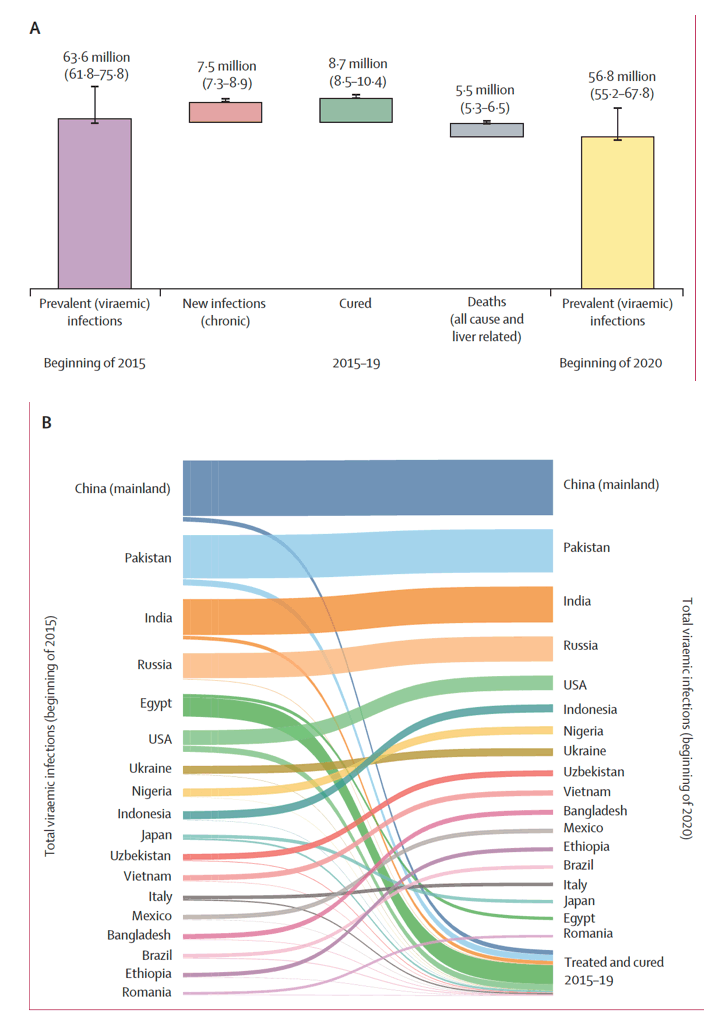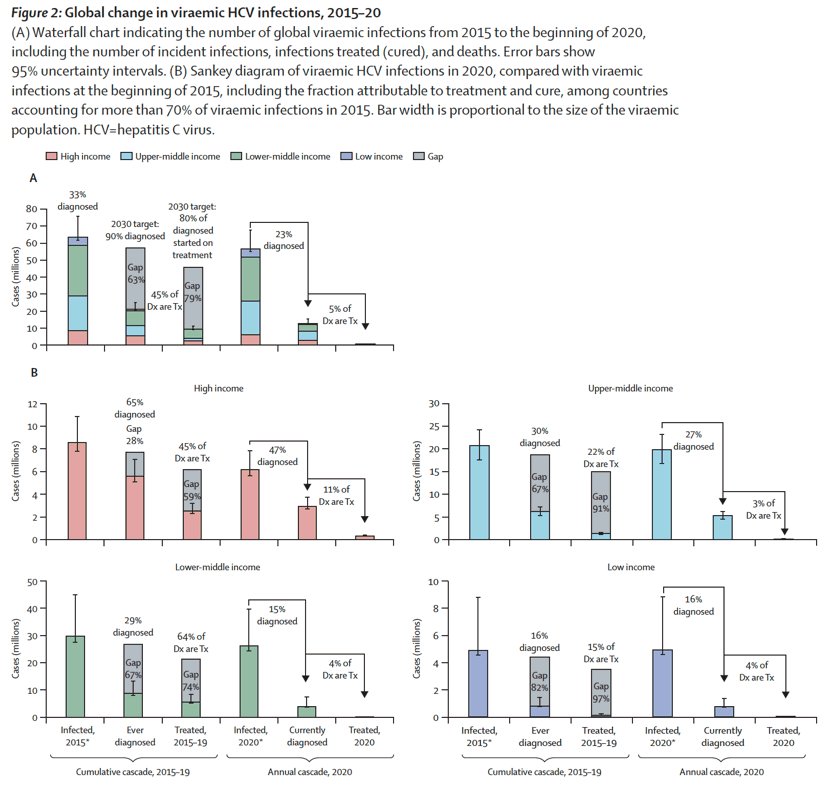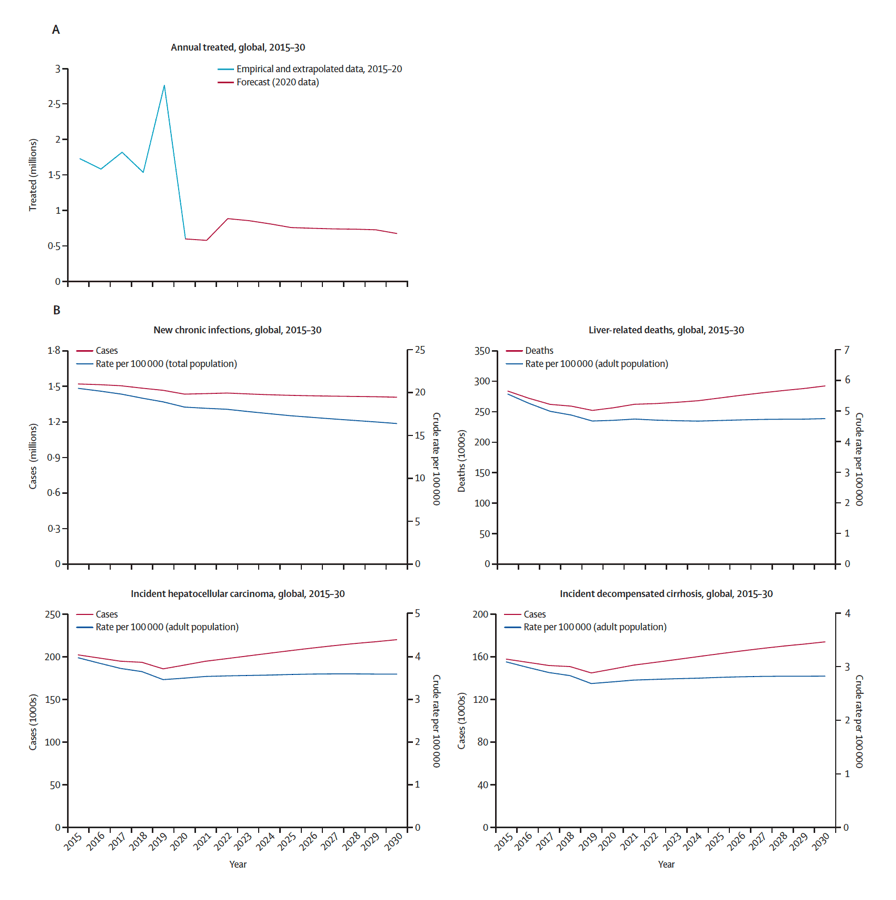| |
Global change in hepatitis C virus prevalence and cascade of care between 2015 and 2020: a modelling study
|
| |
| |
Download the PDF here
"The change in viraemic infections resulted from the addition of 7⋅5 million (7⋅3-8⋅9) new chronic infections, the subtraction of 8⋅7 million (8⋅5-10⋅4) cured infections, and the subtraction of 5⋅5 million (5⋅3-6⋅5) deaths (both all cause and liver related) from 2015 to the end of 2019 (figure 2A)...... the global annual number of new (incident) chronic infections in the total population was expected to remain relatively constant (2% decrease from 1⋅43 million in 2020 to 1⋅40 million in 2030) with a mean of 1⋅42 million new infections expected each year up to the end of 2030 (figure 5B)......in the annual cascade in 2020, an estimated 23% (12⋅9 million [12⋅5-15⋅4]) of the viraemic HCV population was diagnosed and living with a viraemic infection (figure 3); and only 1% of prevalent cases (5% of diagnosed cases) were initiated on treatment (641 000 [623 000-765 000] treated out of 56⋅8 million viraemic; table 2). The total number of treated patients was 10⋅1 million from 2015 to the end of 2020 (figure 3)."
Treatment further declined in 2020, partially due to the depletion of patients awaiting DAA treatment, the COVID-19 pandemic, and other factors. If treatment remains below 1 million patients per year, as is currently estimated, then liver-related deaths and other end-stage outcomes could be expected to increase globally by 2030. Thus, countries should continue to pursue HCV elimination efforts through screening, diagnosis, and timely treatment.
The data presented herein provide a call to action for the global hepatitis community and can serve as a reset point for countries revisiting HCV elimination efforts in the wake of the COVID-19 pandemic.
The Markov model forecasts 2020 prevalence with annual adjustment for incidence, mortality, and cure. Between 2015 (63⋅6 million [95% UI 61⋅8-75⋅8] viraemic infections) and 2020 (56⋅8 million [55⋅2-67⋅8] viraemic infections), there were an estimated 7⋅5 million (7⋅3-8⋅9) new chronic infections, 5⋅5 million (5⋅3-6⋅5) deaths (both all cause and liver related), and 8⋅7 million (8⋅5-10⋅4) cured infections. The ability to calculate and present modelled prevalence estimates over time by country and globally, alongside cascade of care, reflects the utility of modelling in elimination monitoring activities. Of the 9⋅5 million people estimated to have been initiated on DAA therapy between 2015 and the end of 2019, more than a third (3⋅5 million [36%]) were in Egypt.
On the basis of empirical data and future treatment forecasts, the global annual number of new (incident) chronic infections in the total population was expected to remain relatively constant (2% decrease from 1⋅43 million in 2020 to 1⋅40 million in 2030) with a mean of 1⋅42 million new infections expected each year up to the end of 2030 (figure 5B). By 2030, end-stage outcomes in the adult population (age ≥18 years; liver-related deaths, hepatocellular carcinoma, and decompensated cirrhosis) were expected to increase by 14-17% relative to 2020 (257 000 liver-related deaths in 2020 to 290 000 in 2030; 190 000 incident hepatocellular carcinoma cases in 2020 to 220 000 in 2030; and 148 000 incident decompensated cirrhosis cases in 2020 to 174 000 in 2030; figure 5B).
The global prevalence of viraemic (HCV RNA-positive) HCV infection was estimated to be 0⋅7% (95% UI 0⋅7-0⋅9) at the beginning of 2020, corresponding to 56⋅8 million (95% UI 55⋅2-67⋅8) viraemic infections. This represents a reduction of 6⋅8 million viraemic infections from a revised 2015 (beginning of year) estimate of 63⋅6 million (61⋅8-75⋅8) viraemic infections (0⋅9% [0⋅8-1⋅0] prevalence). The change in viraemic infections resulted from the addition of 7⋅5 million (7⋅3-8⋅9) new chronic infections, the subtraction of 8⋅7 million (8⋅5-10⋅4) cured infections, and the subtraction of 5⋅5 million (5⋅3-6⋅5) deaths (both all cause and liver related) from 2015 to the end of 2019 (figure 2A). The progression of viraemic infections from 2015 to 2020 among the 20 countries with the largest number of viraemic infections is shown in figure 2B. Most notably, Egypt's national treatment programme treated almost 3⋅5 million people from 2015 to 2019; the country moved from having the fifth most infections globally in 2015 to the 17th most infections globally by 2020.
The cascade of care was estimated in two ways (figure 3). First, a cumulative cascade was calculated relative to the 2015 baseline, which showed that 33% (21⋅1 million [95% UI 20⋅5-25⋅2]) of the viraemic population in 2015 had ever received a diagnosis (figure 3), with 9⋅5 million (95% UI 9⋅2-11⋅3) people cumulatively initiated on treatment (45% of 21⋅1 million diagnosed) between 2015 and 2019 (figure 3, figure 4, appendix p 35).
Second, in the annual cascade in 2020, an estimated 23% (12⋅9 million [12⋅5-15⋅4]) of the viraemic HCV population was diagnosed and living with a viraemic infection (figure 3); and only 1% of prevalent cases (5% of diagnosed cases) were initiated on treatment (641 000 [623 000-765 000] treated out of 56⋅8 million viraemic; table 2).
The total number of treated patients was 10⋅1 million from 2015 to the end of 2020 (figure 3).



| |
| |
| |
|
|
|